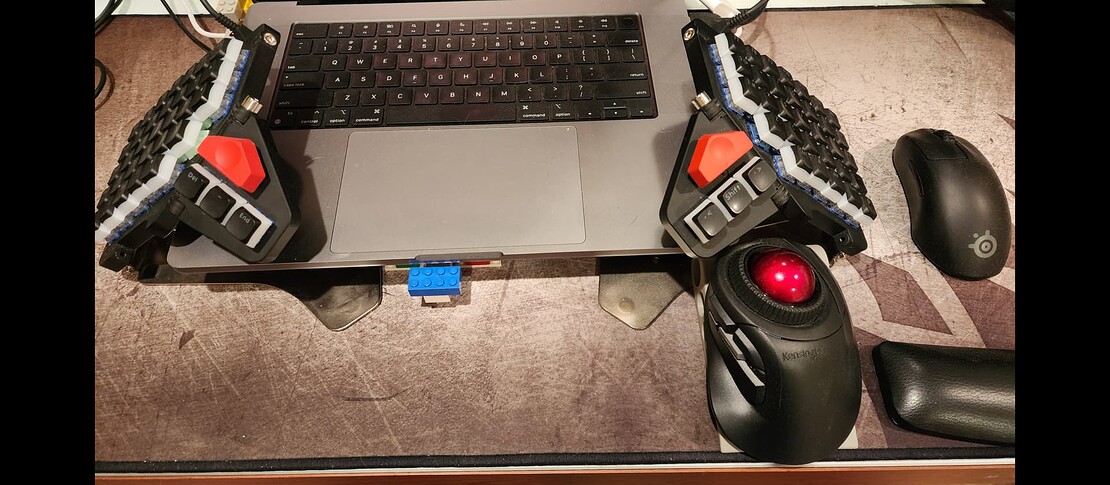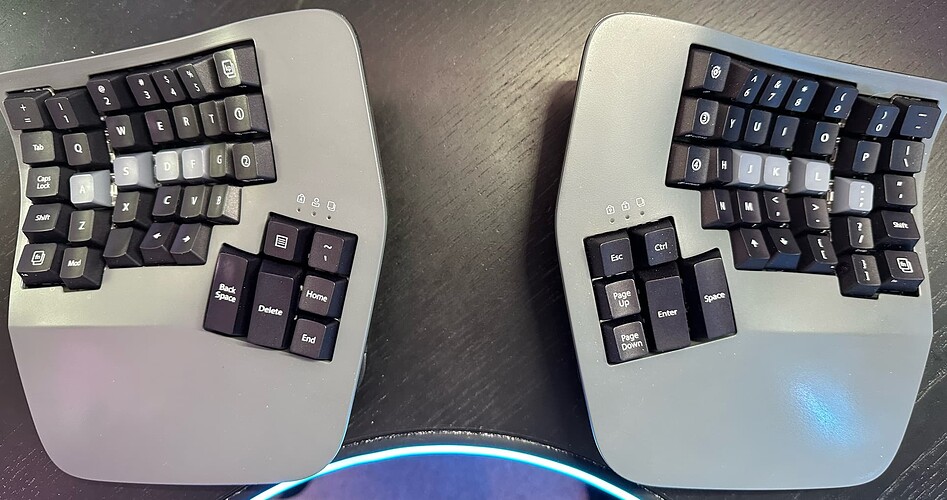I can’t imagine not having my number pad, but there are entire lines of keyboards coming out now where numpad isn’t even an option.
Cost-cutting with the thought that numpads are for specific use-cases and otherwise duplicate keys already available? Makes keyboards compact, mobile, perhaps?
I know our finance team would hate to lose it, and probably some Excel users, but I don’t know if others would miss it much. I had people request compact keyboards and even when the numpad is an option or separate, they didn’t want or use it.
I develop crippling RSI with keyboards with a numpad, so I only use ones without. Just having my mouse 6” further to the right is enough to cause serious pain.
Yes the most common reason is for gaming, so your mouse is closer to your body center.
I’m basically fine with TKL but any smaller than that, anything compromising the function keys, arrows, or the insert cluster is a complete no-go.
Wow I never thought if that.
I’m old enough that I learned how to use a standalone adding machine in high school for Accounting class, so I got used to being able to input numbers very quickly on a keypad. I would guess those without such exposure or major numerical data entry work would not have strong feelings about wasting desk space with the keypad.
For work I’ve been using a 65% keyboard for the longest time, which is ten-keyless, function-keyless, and moves the insert cluster to a column on the right. But keeps the arrow keys.
For programming it’s been great, the idea being the less you need to move your fingers to distant keys the more efficient and comfortable it is.
I do have a little stand-alone Microsoft bluetooth numpad for emergencies but it’s gathering dust. :)
Don’t you need an End key? Otherwise, it’s adorable.
Not a dedicated one, End is Function + right arrow.
To be honest I rarely use Home, PgUp or PgDn either as Fn + arrow keys does all those.
I use the numpad always to enter digits and for calculator functions. So awkward with the keys across the top of the keyboard. I do also get crippling RSI though and maybe that’s the reason.
Yea, that’s what I don’t get. Using the numbered keys up there is a nightmare.
If you’re typing alpha numerics all day, moving your whole hand back and forth to the numpad over and over is the nightmare. :)
With the top row keys you’re just moving your fingertips.
Can someone explain what some of these descriptions mean off the Cherry MX site?
Directly? Powerful? Purposeful???
What… do other keys lack a purpose in life?
I used to think a numpad was non-negotiable too. But now… well, here’s my current workstation:
I was getting pretty bad RSI, and after some research decided to really rethink how much strain the standard setup was putting on my right hand, particularly the pinky. My left hand was staying put and handling its half of the typing, while my right hand was also doing half the typing (including some obnoxiously high-frequency keys straining the pinky at awkward extensions), plus the mouse, plus the numpad, plus the arrow / insert cluster, each of which was its own separate position that required moving the whole hand around.
IMO there are a lot of things that are the way they are out of inertia rather than because they’re particularly good or well thought-out. So about a year ago, I ordered this (ZSA Moonlander) and decided to adjust my usage. I figure I probably have another ~20 years of daily computer use for work, so putting in time to improve my comfort, health, and efficiency now will pay off in the long run. It’s definitely been a process with a learning curve, but well worth it.
The thing is, I still have all the keys I need (plus more), but now instead of moving my hand to the key I want to press, I bring the key I want to press to where my hand already is. For example, when holding the inner thumb key on either hand, my left-hand home block becomes a numpad and my right-hand home block becomes arrow keys and related text-navigation shortcuts.
After getting used to it, this is massively better than a standard physical numpad and arrow keys. Not only is it always right there at my fingertips, but because the numpad is on the left hand, it splits the workload and makes it easy to get into a rhythm between the hands. For example, on a spreadsheet, the right hand is navigating between cells (either with the arrow keys or mouse/trackball), while the left hand is entering them, rather than the right hand needing to constantly switch off. I’ve been learning how to do some CAD for 3D printing on my gaming system, which still has a normal keyboard, and really miss the setup from my work system.
That said, all this is several steps further than a “normal” tenkeyless board. Personally I wouldn’t want to give up the physical numpad without moving it to a layer, so I’m not really sure what the rationale for their popularity. I suppose having an external numpad on the left of the keyboard would be better than a built-in one on the right, since it balances the hands better and lets you bring the mouse in closer to the center, but I doubt most people do that either. Probably more about just being used to laptops and not regularly doing number-intensive workloads.
Don’t overthink the marketing drivel. If you’re trying to get a sense of what different switches feel like, you could order a tester.
I’m really intrigued by this. I spent awhile 15 years ago trying to find an ergonomic mouse that worked for me. I ultimately failed because my hands were too big for all of them. But changing my keyboard layout makes sense. Are you able to easily return to a normal keyboard setup? That would be my worry. I have dedicated office and home PCs but I also work on dozens of computers throughout my workplace. I can’t bring the keyboard to all of them.
Yep! When I first got this, I went full immersion and didn’t use a normal keyboard or the QWERTY layout at all for the first month or so. After that, I was rusty, slow, and mistake-prone the first time I went back to one. But decades of muscle memory doesn’t just evaporate that easily, and pretty soon I was back near my previous speed and accuracy levels.
Now I probably type 10% of the time on a regular QWERTY keyboard (where I’m actually still slightly faster for regular English prose) and 90% of the time on the Moonlander using Mûmak (where I’m faster for stuff like programming and much more comfortable regardless). But I can switch back and forth fluently without issue.
And yeah, I’ve also struggled with this due to my giant hands, and it was a significant part of my RSI issues. Shifting to finger-operated trackballs helped a lot, though. And then adding mouse buttons onto the keyboard also makes a huge difference.
Happy to answer any questions, share my layout, or go into exhaustive detail about any of this stuff, but don’t want to derail this thread.
Thanks! I’m considering pulling the trigger on one even at $400, particularly if it saves me pain. I spend at least a couple of months every year wearing wrist braces for forearm and shoulder pain due to typing and mousework. I might indeed hit you up for layout tips if I do.
Ouch, that sounds awful. And yeah, the cost of all of these high-end ergonomic keyboards is a big deterrent. There are somewhat cheaper options out there through various boutique builders, or by getting a kit and putting it together yourself, though there are definite tradeoffs either way. You can also find some split, tentable keyboards starting around $100, and that’s definitely a good first step over a normal keyboard, but without thumb clusters and easy programmability it’s somewhat limited. I first tried a Kinesis Gaming Freestyle Edge. It convinced me that I was on the right track for helping my RSI but needed to go further, so I wound up returning it.
Was waffling over what to get instead and trying to justify the expense. But fortunately, around that time I started a new job that gave a yearly stipend for home office equipment, and I was already set in terms of chair/desk/monitor so could spend it all on the keyboard. Definitely would have been a harder sell to spend my own money sight unseen, though in hindsight it would have been well worth it.
BTW, there are some new options that have come on the market in the last year. If I were buying right now, I would seriously consider the Glove80, and there’s also the Dygma Defy, or the ZSA Voyager.
I’ll raise y’all a Kinesis Advantage 360 pro as my TKL solution. I’ve had this for over a year and have written 2 1/2 novels on it so far. It has saved my fingers and wrists after years of being a stupid typist. I had to learn proper touch typing and my hands never move while I type. This thing is ridiculously expensive. I work from home full time and am self-employed so it was a nice little tax write off. I didn’t care for the keycaps this came with and ended up purchasing a different set that Kinesis makes.




